Étiquette : Bande/Tape

Fritz Busch – Radio Symfoniorkestret Statsradiofoniens Kor
Orchestre et Chœurs de la Radio Danoise / Danish Radio Orchestra and Choir
Copenhagen Odd Fellow Palæet
Source: Bandes 38 cm/s / 15 ips Tapes
Haydn Die Schöpfung Hob. XXI:2 – Part II:
Erna Berger, soprano; Julius Patzak, tenor; Alexander Kipnis, Bass – 6 December 1934
n°14 ‘Und Gott sprach’ & n°15 Arie ‘Auf starkem Fittiche’ Erna Berger
n°20 ‘Und Gott sprach’ & n°21 ‘Gleich öffnet sich der Erde Schoss’ Alexander Kipnis
n°23 ‘Und Gott schuf den Menschen’ & n°24 Arie ‘Mit Würd und Hoheit angetan’ Julius Patzak
n°28 Chor ‘Vollendet ist das grosse Werk’*
*inédit/never published before in any format
______________
Beethoven: Erika Rokyta, soprano; Ingeborg Steffensen, mezzo; Koloman von Pataky, tenor; Alexander Kipnis, bass
Missa Solemnis Op.123 Sanctus – 14 February 1935
Symphonie n°9 Op.125- IV Presto – Allegro assai – Presto – 12 April 1934**
** Report, Montage et ‘Mastering’ / Transfer, Editing and Mastering: Charles Eddi
Alexander Kipnis et Fritz Busch se sont produits ensemble à de nombreuses reprises, comme ici à la Radio Danoise, mais aussi au Teatro Colón de Buenos-Aires, notamment Mozart Don Giovanni (Commendatore), Strauss Arabella (Graf Waldner), Rosenkavalier (Ochs), Wagner Fliegende Hollander (Daland), Götterdämmerung (Hagen), Lohengrin (König Heinrich), Parsifal (Gurnemanz), Rheingold (Fasolt), Tannhäuser (Hermann), Tristan (Marke), et Walküre (Hunding), à l’Opéra de Montevideo pour Wagner Walküre (Hunding), et brièvement au MET pour deux opéras de Wagner, Tristan und Isolde (Marke) et enfin Tannhäuser (Hermann) pour la dernière représentation en public d’un opéra par Kipnis le 6 mai 1946.
Au milieu des années trente, Kipnis était à son sommet, et ces enregistrements le montrent, dont le couronnement est sa participation véritablement historique à la Neuvième Symphonie de Beethoven, où il est bien meilleur qu’avec Toscanini (Teatro Colón 24 juillet 1941 – Music & Arts CD-1119).
Dans le Finale de la ‘Neuvième’, Busch prend un maximum de risques, en n’hésitant pas à pousser l’orchestre et les chœurs au-delà de leurs limites, ce qui par moment mène l’exécution au bord de la rupture. On n’est pas habitué à une telle tension de la part de ce chef, dont la réputation est plutôt celle d’un classique. Sur ce plan, cet enregistrement est vraiment un témoignage unique.
On notera que l’enregistrement du Chœur n°28 qui termine la deuxième partie de la Création (Die Schöpfung) de Haydn est un inédit.
Nous pouvons également à cette occasion entendre d’autres chanteurs célèbres, à savoir Erna Berger, Julius Patzak et Koloman von Pataky.


Odd Fellow Palæet
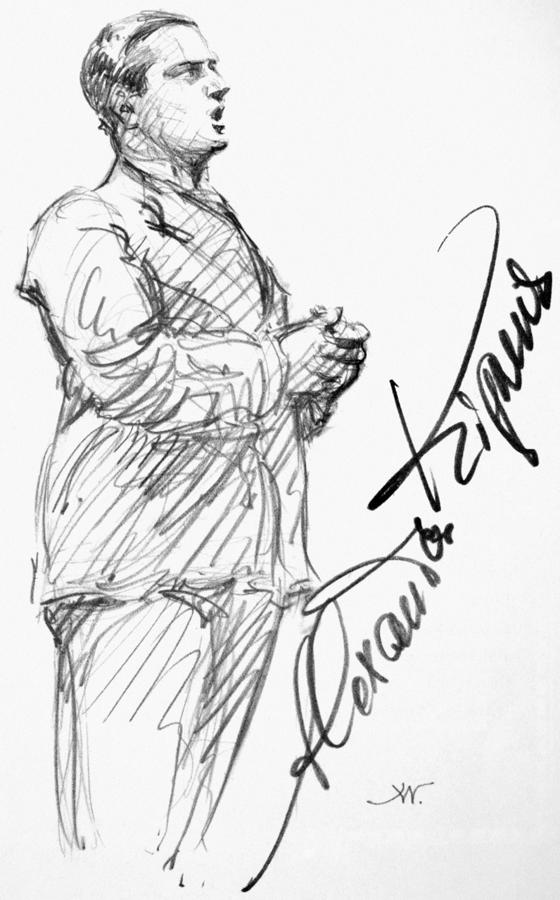

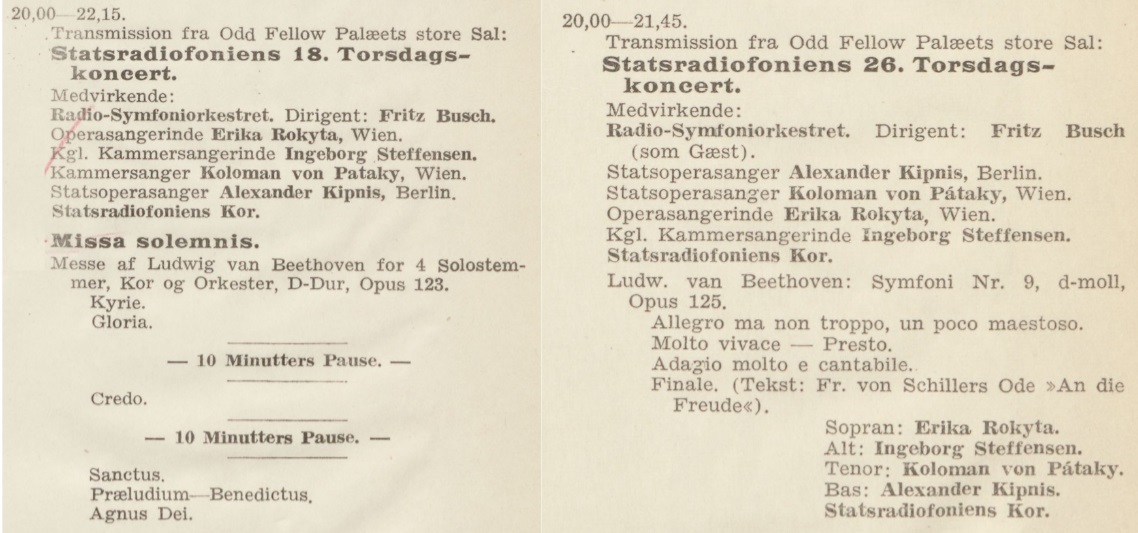
Alexander Kipnis and Fritz Busch have performed together on numerous occasions, such as here at the Danish Radio, but also at the Teatro Colón in Buenos Aires, notably Mozart Don Giovanni (Commendatore), Strauss Arabella (Graf Waldner), Rosenkavalier (Ochs), Wagner Fliegende Hollander (Daland), Götterdämmerung (Hagen), Lohengrin (König Heinrich), Parsifal (Gurnemanz), Rheingold (Fasolt), Tannhäuser (Hermann), Tristan (Marke), and Walküre (Hunding), at the Montevideo Opera for Wagner Walküre (Hunding), and briefly at the MET for two Wagner operas, Tristan und Isolde (Marke) and finally Tannhäuser (Hermann) for Kipnis’ last public performance of an opera on May 6, 1946.
By the mid-1930s, Kipnis was at his peak, and these recordings show it, the crowning of which being this truly his historical performance in Beethoven’s Ninth Symphony, where he is very much better than with Toscanini (Teatro Colón July 24, 1941 – Music & Arts CD-1119).
In the Finale of the ‘Ninth’, Busch takes a maximum of risks, not hesitating to push the orchestra and the chorus beyond their limits, which at times brings the performance to the brink of breakdown. We are not used to such tension from this conductor, whose reputation is rather that of a classic. In this respect, this recording is truly a unique testimony.
It should be noted that the recording of Chorus n°28, which ends the second part of Haydn’s Creation (Die Schöpfung), was never published before.
We can also enjoy hearing other famous singers, namely Erna Berger, Julius Patzak and Koloman von Pataky.

Mason Jones Cor / Horn – Philadelphia Orchestra Eugene Ormandy
Enregistrement / Recording:
Concerto n°1 K.412: February 26, 1961
Concerto n°2 K.417:December 3, 1961
Concerto n°3 K.447: February 5, 1961
Concerto n°4 K.495: March 11, 1962
Source: Bande / Tape MQ 796 (4 pistes / 4 tracks; 19 cm/s / 7.5 ips)
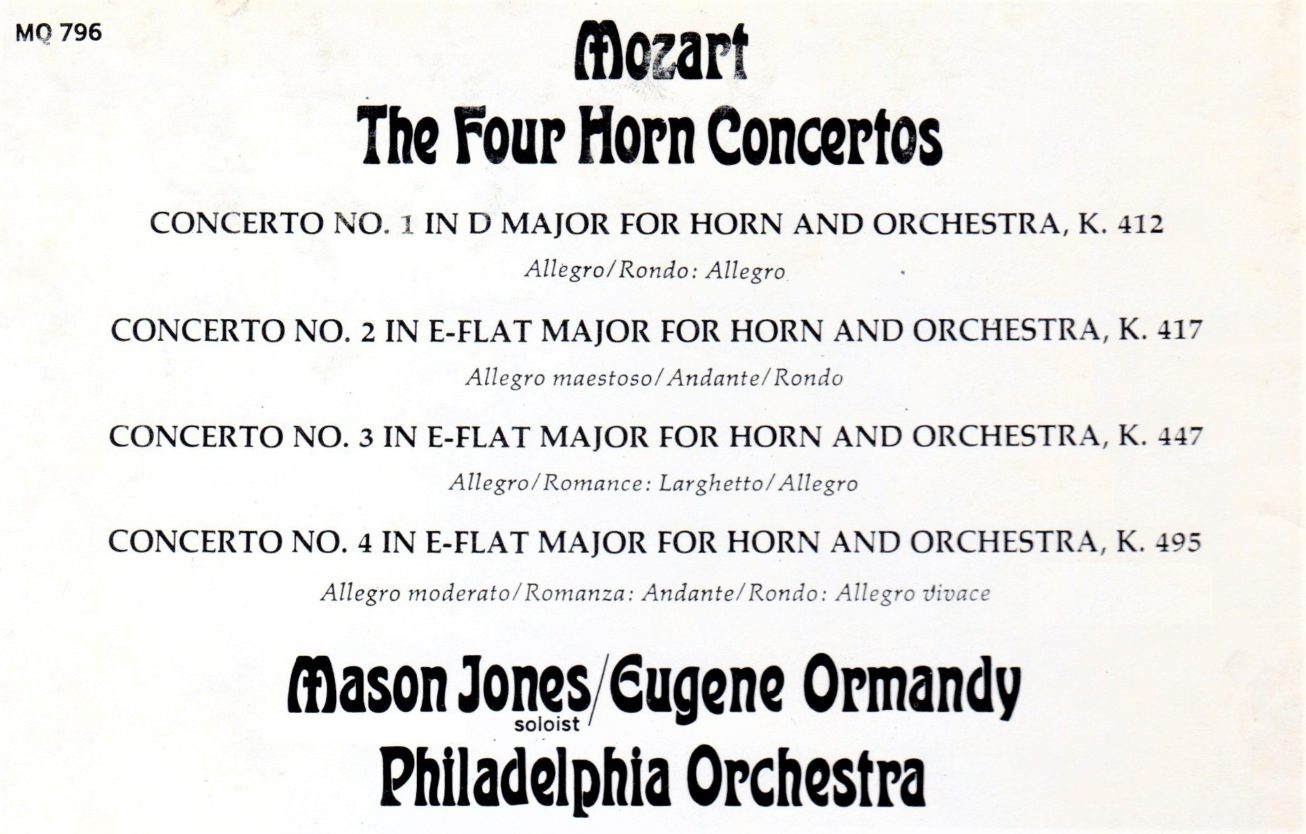
Mason Jones (1919-2009) a rejoint le Philadelphia Orchestra en 1938 en tant que troisième cor, avant d’en devenir le cor solo l’année suivante. Pendant la Deuxième Guerre Mondiale, il a servi comme cor solo de la Marine Band (Washington DC). En 1946, il a retrouvé son poste de cor solo au Philadelphia Orchestra qu’il a conservé jusqu’à sa retraite en 1978. Ces enregistrements des concertos de Mozart mettent en évidence son exceptionnel talent face notamment aux solistes britanniques de l’époque: Dennis Brain, Barry Tuckwell et Alan Civil.
Une particularité: il joue le Rondo du Concerto n°1 K.412 sur un cor naturel (un ‘Waldhorn’ sans pistons).
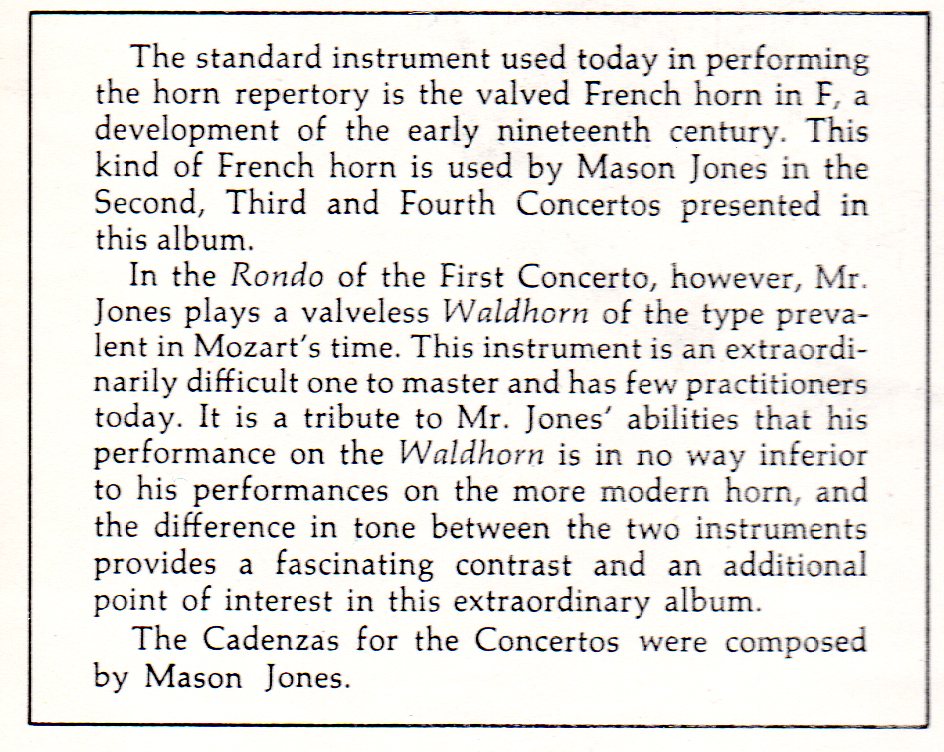
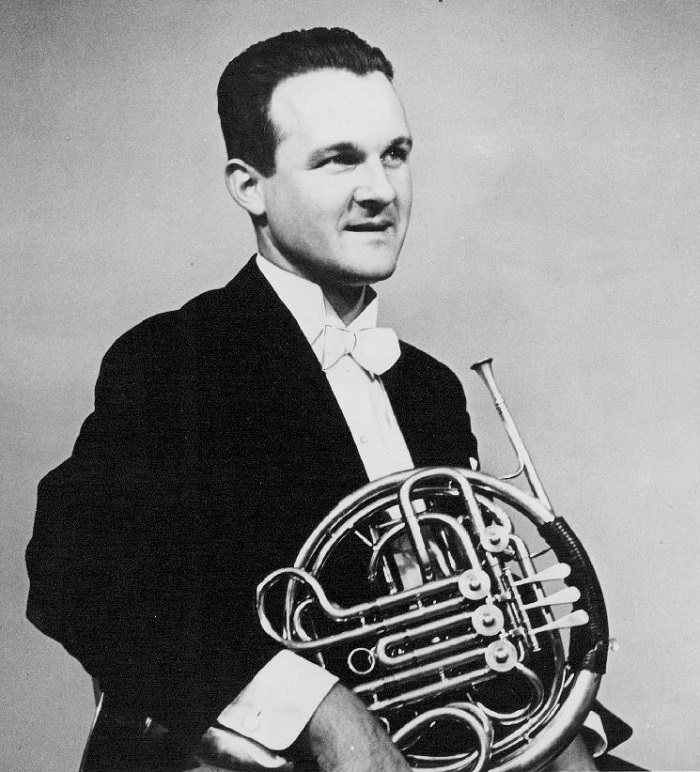
Mason Jones – 1957
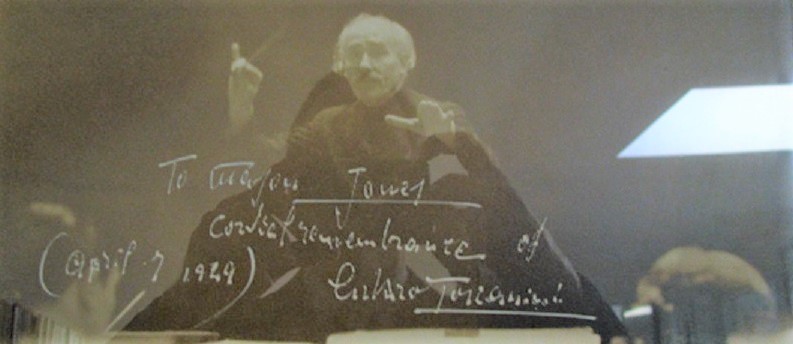
Mason Jones (1919-2009) joined the Philadelphia Orchestra in 1938 as third horn, before becoming principal horn the following year. During World War II, he served as principal horn of the Marine Band (Washington DC). In 1946 he returned to the Philadelphia Orchestra as principal horn, a position he held until his retirement in 1978. These recordings of the Mozart concertos put forward his exceptional talent, especially if we compare him with the British soloists of the time: Dennis Brain, Barry Tuckwell and Alan Civil.
A particularity: he plays the Rondo of the Concerto n°1 K.412 on a natural horn (a valveless ‘Waldhorn’).
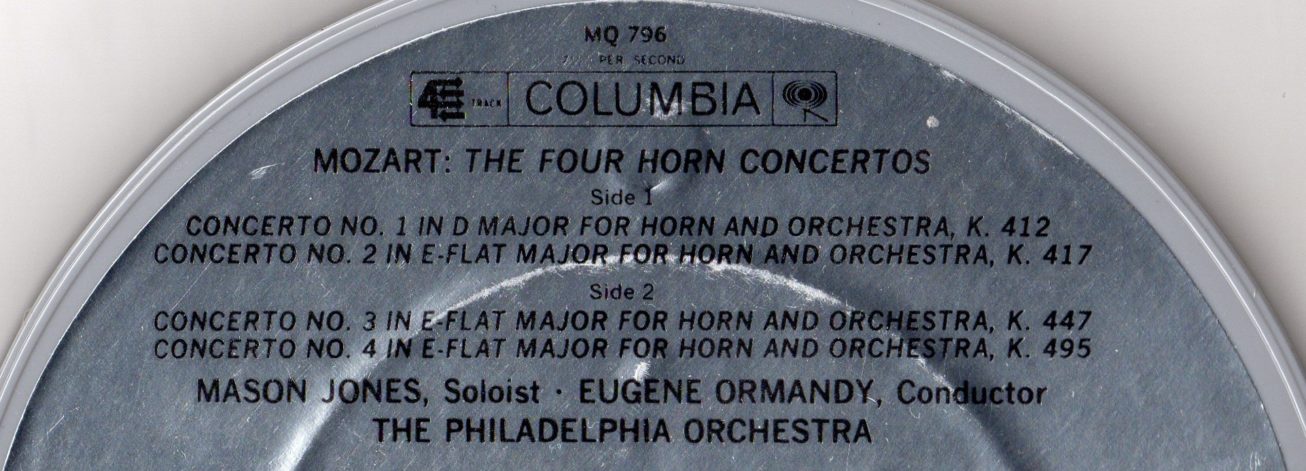

Solomon – Philharmonia Orchestra André Cluytens
London Kingsway Hall
Concerto n°2 Op.19: 3,5 & 6 November 1952
Concerto n°4 Op.58: 3-5 November 1952
Source: Bande / Tape HTA 1 ( 2 pistes 19 cm/s / 2 tracks 7.5 ips)
En septembre 1954, His Master’s Voice (HMV) a publié sa première liste commerciale de bandes pré-enregistrées qui étaient copiées sur les mêmes magnétophones que ceux utilisés par les studios, en utilisant le même type de bandes que lors des séances d’enregistrements. La qualité obtenue reste étonnante, même si la vitesse (19 cm/s) n’est que le quart de celle qui était mise en œuvre (76 cm/s) lors des enregistrements, et le seul inconvénient est un léger souffle de bande.

Pour la toute première de la série, référencée HTA 1, HMV a choisi ces deux concertos de Beethoven interprétés par Solomon et Cluytens, deux réalisations magnifiques où les deux musiciens ont accordé leurs conceptions à la perfection. La prise de son, très équilibrée et d’une ampleur très agréable, reflète bien l’acoustique chaleureuse de Kingsway Hall. La bande, qui date donc de 1954, est en très bon état, sauf de temps en temps (dans le concerto n°4) quelques bruits ‘électriques’ qui proviennent probablement de parasites électriques lors de la copie de la bande.

In September 1954, His Master’s Voice (HMV) published its first commercial list of pre-recorded tapes that were dubbed onto the same tape recorders used by the studios, and using the same tapes as during the recording sessions. The quality obtained is still amazing, even if the speed (19 cm/s) is only a quarter of the speed that was used (76 cm/s) during the recordings, and the only drawback is a slight tape hiss.
For the very first of the series, referenced HTA 1, HMV chose these two Beethoven concertos performed by Solomon and Cluytens, two magnificent interpretations in which the two musicians matched their views to perfection. The sound recording, very balanced and with a very pleasant fullness, reflects well the warm acoustics of Kingsway Hall. The tape, which dates from 1954, is in very good condition, except for occasional ‘electrical’ noises (in Concerto No. 4), which were probably due to electrical interferences when the tape was dubbed.
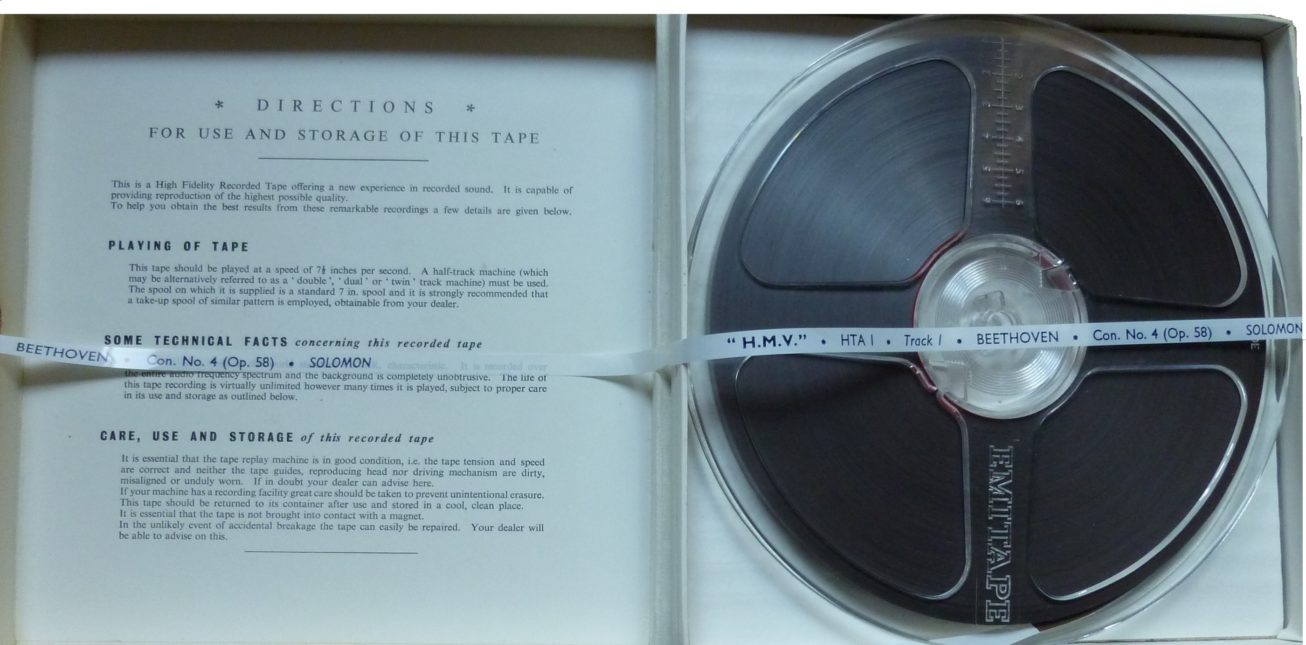

Guido Cantelli – New York Philharmonic (NYPO)
Carnegie Hall – March 29, 1953
Source: Bande/Tape 19 cm/s / 7.5 ips

Les Tableaux d’une Exposition de Moussorgski, c’est une des œuvres que Cantelli a le plus dirigées. Outre deux concerts (22 janvier 1951, 27 février 1952) et un enregistrement officiel avec le NBC SO, deux concerts avec le Boston SO (6 et 7 février 1953), et trois avec le Philharmonia Orchestra (21 et 23 octobre 1952 à Londres et 11 septembre 1954 à Edinburgh), c’est avec le New York Philharmonic (NYPO) que l’on trouve le plus grand nombre d’exécutions dont douze à New-York (24-27 janvier 1952; 25-27 et 29 mars 1953; 13, 14, 16 janvier et 19 mars 1955) et onze en tournée entre le 20 avril et le 21 mai 1955 d’une part, et entre le 7 et le 25 septembre 1955 d’autre part.
Le présent enregistrement reflète la deuxième partie du concert du 29 mars 1953 dont la première partie (Rossini Il Signor Bruschino Ouv. et Beethoven Concerto n°1 Op. 15 avec Rudolf Serkin) est déjà disponible sur le présent blog*.
Pour ces ‘Tableaux’, tant l’interprétation, beaucoup plus expressive, que la prise de son, sont supérieures à celles du concert du 27 janvier 1952 (Coffret Music & Arts CD-1056).
Dans son article dans la revue ‘Musical America’ sur cette série de concerts de fin mars 1953, Ronald Eyer, après avoir remarqué que Cantelli dirigeait les Tableaux de Moussorgski avec un dynamisme et un sens du style qui les faisait sonner comme autant de chefs d’œuvre a proposé l’explication suivante: ‘C’est peut-être le secret du génie de Mr. Cantelli: il aborde tout comme s’il s’agissait du plus grand morceau de musique jamais écrit’.
*Rossini Il Signor Bruschino Beethoven Concerto n°1 Op. 15
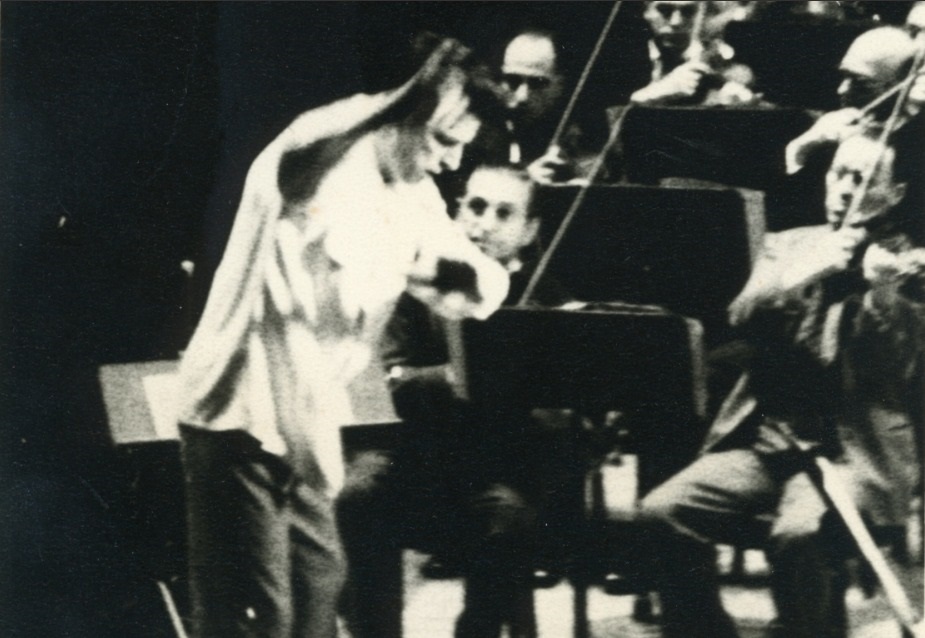
Mussorgsky’s Pictures at an Exhibition is one of the works Cantelli conducted the most. In addition to two concerts (January 22, 1951, February 27, 1952) and an official recording with the NBC SO, two concerts with the Boston SO (February 6 and 7, 1953), and three with the Philharmonia Orchestra (October 21 and 23, 1952 in London and September 11, 1954 in Edinburgh), it is with the New York Philharmonic (NYPO) that we find the greatest number of performances, including twelve in New York (January 24-27, 1952; 25-27 and 29 March 1953; 13, 14, 16 January and 19 March 1955) and eleven on tour between 20 April and 21 May 1955 on the one hand, and between 7 and 25 September 1955 on the other hand.
The present recording reflects the second part of the concert of March 29, 1953, the first part of which (Rossini Il Signor Bruschino Ouv. and Beethoven Concerto No. 1 Op. 15 with Rudolf Serkin) is already available on this blog.
For these ‘Pictures’, Both the interpretation, much more expressive, and the sound recording, are superior to those of the January 27, 1952 concert available in the Music & Arts Boxset CD-1056.
In his review in ‘Musical America’ of this series of end of March 1953 concerts, Ronald Eyer, after having remarked that Cantelli played the Moussorgsky Pictures with a dynamism and a sense of style that made them sound as momentous as masterpieces, attempted the following explanation: ‘This is perhaps the secret of Mr. Cantelli’s genius: he approaches everything as though it were the greatest piece of music ever written’.

Boskovsky Ensemble – III
HAPPY NEW YEAR 2023 /BONNE ANNEE 2023


Œuvres de Lanner, Mozart, Schubert, et de J. Strauss Sr. et Jr.
Boskovsky Ensemble (chefs de pupitre du WPO)
Violon I : Willi Boskovsky (1908-1991) « Stimmführer » des violons I de 1934 à 1938, puis Konzertmeister de 1938 à 1970
Violin II : Wilhelm Hübner (1914-1996) « Stimmführer » des violons II de 1954 à 1964, « Vorgeiger » ensuite jusqu’en 1980 (retraite)
Violin III et Alto: Rudolf Streng (1915-1988) violon I de 1938 à 1959; alto solo de 1959 à 1980 (retraite)
Contrebasse: Otto Rühm (1906-1979) contrebasse solo de 1955 à 1971 (retraite)
Flûte – Josef Niedermayr (1900-1962) flûte solo de 1933 à 1962
Clarinette – Rudolf Jettel (1903-1981) clarinette solo de 1945 à 1968 (retraite)
Cors: Otto Nitsch (1906-1982) 2ème cor de 1941 à 1971; Roland Berger(1937) 3ème cor au Wiener Staatsoper (1955); cor solo de 1961 à 1984; de nouveau 3ème cor de 1984 à 1993 (retraite)
L’enregistrement a été réalisé en 1960 dans la Festsaal du Casino de Baumgarten.
Source: Bande / Tape VTC-1634 – 4 pistes / 19 cm/s – 4 tracks 7.5 ips
Les œuvres sont les suivantes:
01- Johann Strauss Sr. : Chinesischer Galopp 2 violons, alto, contrebasse, flûte, clarinette, 2 cors
02- Johann Strauss Sr. : Kettenbrücke Walzer 2 violons, contrebasse
03- Johann Strauss Sr. : Eisele und Beisele Sprünge 2 violons, alto, contrebasse, flûte, clarinette, 2 cors
04- Josef Lanner: Styrian Dances 2 violons, alto, contrebasse
05- Wolfgang Amadeus Mozart: 3 Contredanses K.462-1 6&5-24-88 – 2 violons, alto, flûte, clarinette, 2 cors
06- Johann Strauss Jr: Wiener Gemüths 2 violons, alto, contrebasse
07-Wolfgang Amadeus Mozart: 4 Deutsche Tänze K.600 n°3, K.605 n°1, K.686 n°11, K.600 n°1 – 2 violons, alto, flûte, clarinette, 2 cors
08-Franz Schubert: 8 Wälzer und Ländler Op.9 n°2, Op.18 n°1,3, Op.9 n°14,35, Op.33 n°10, Op.127 n°15,18
09-Johann Strauss Jr: Champagne Galopp
10-Josef Lanner: Die Werber Walzer 3 violons, contrebasse
11-Johann Strauss Sr: Cachucha Galopp
Parmi les œuvres de Johann Strauss Sr (1804- 1849), on trouve un de ses premiers grands succès, la ‘Kettenbrücke Walzer’, composée en 1828 pour célébrer le premier pont suspendu (à chaînes) de Vienne, construit à proximité du palais Rasoumovsky et inauguré en 1825, un sujet inattendu pour une valse!
L’ère de la Famille Strauss s’est ainsi ouverte immédiatement après Haydn, Mozart, Beethoven et Schubert qui ont également composé de la musique populaire.
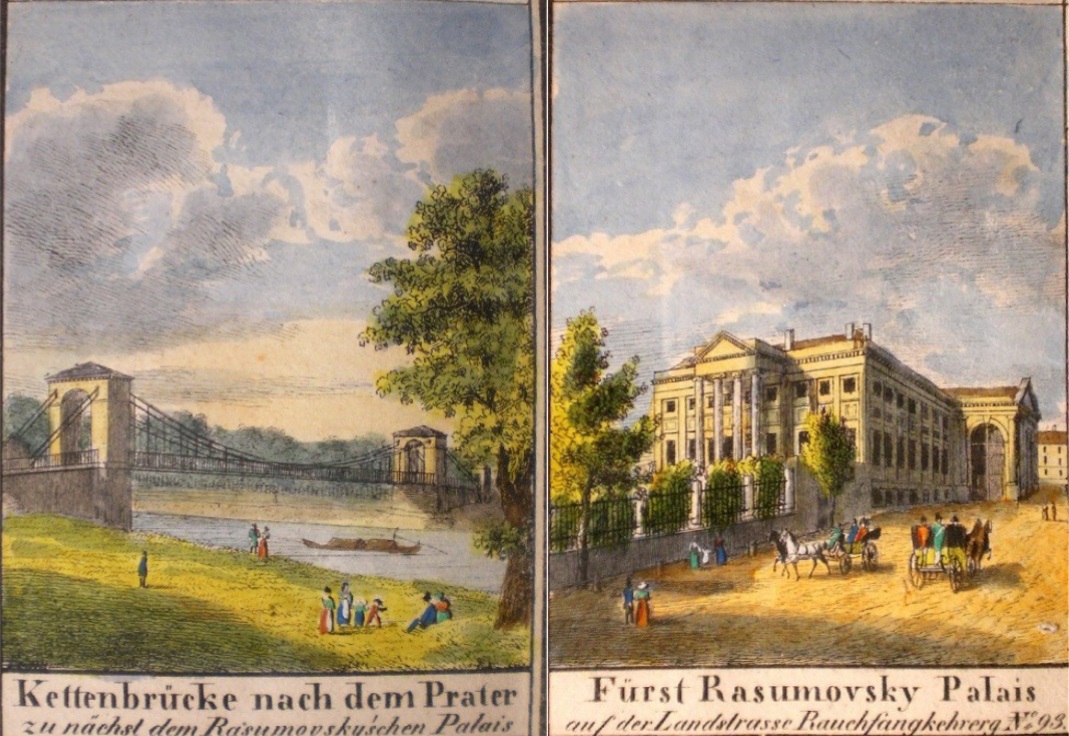
Kettenbrücke beim Palais Rasumovsky nach dem Prater

Works by Lanner, Mozart, Schubert, and by J. Strauss Sr. and Jr.
Boskovsky Ensemble (first desk men of the WPO):
Violin I : Willi Boskovsky (1908-1991) « Stimmführer » of violins I from 1934 to 1938, then Konzertmeister from 1938 to 1970
Violin II : Wilhelm Hübner (1914-1996) « Stimmführer » of violins II from 1954 to 1964, then « Vorgeiger » until 1980 (retirement)
Violin III and Viola: Rudolf Streng (1915-1988) violin I from 1938 to 1959; solo viola from 1959 to 1980 (retirement)
Double-bass: Otto Rühm (1906-1979) solo double-bass from 1955 to 1971 (retirement)
Flute: Josef Niedermayr (1900-1962) in the orchestra since 1921; solo flute from 1933 to 1962
Clarinet: Rudolf Jettel (1903-1981) solo clarinet from 1945 to 1968 (retirement)
Horns: Otto Nitsch (1906-1982) 2nd horn from 1941 to 1971; Roland Berger(1937) 3rd horn at the Wiener Staatsoper (1955); solo horn between 1961 and 1984; then again 3rd horn between 1984 and 1993 (retirement)
The recording was made in 1960 in the Festsaal of the Baumgarten Casino.
Source: Tape VTC-1634
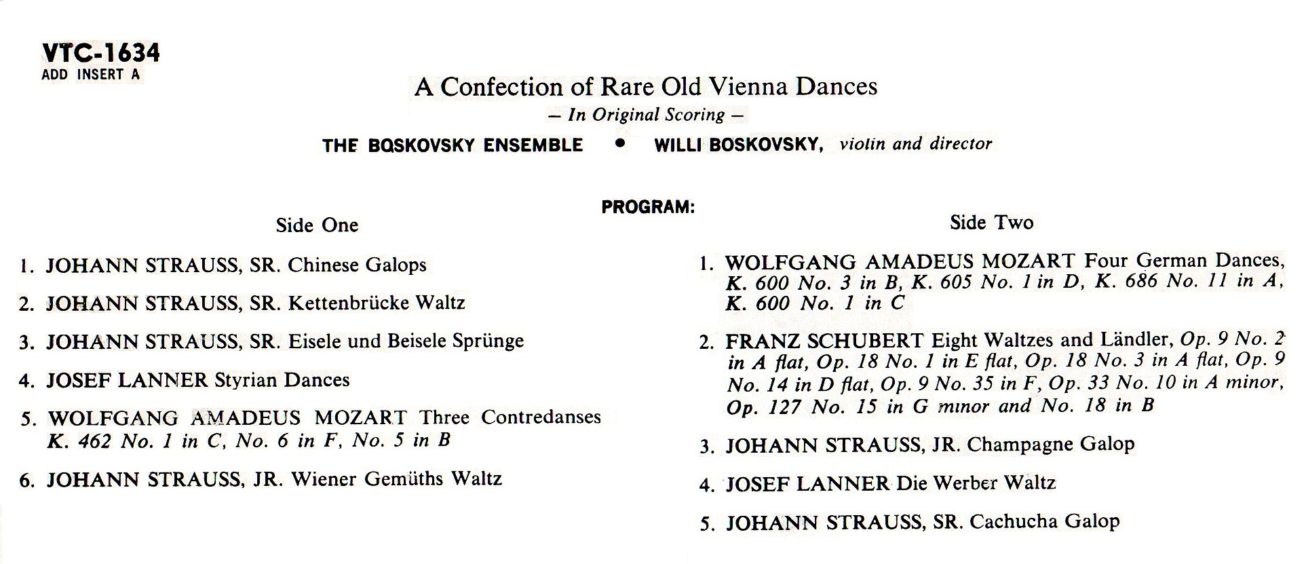
Among the works by Johann Strauss Sr (1804- 1849), we find one of his first great ‘hits’, the ‘Kettenbrücke Walzer’, composed in 1828 to celebrate the first chain suspension bridge in Vienna, built near the ‘Rasumovsky Palais’ and inaugurated in 1825, a rather unexpected subject for a waltz!
Then, the Strauss Family era took over shortly after Haydn, Mozart, Beethoven and Schubert who also composed popular music.

Les liens de téléchargement sont dans le premier commentaire. The download links are in the first comment.



